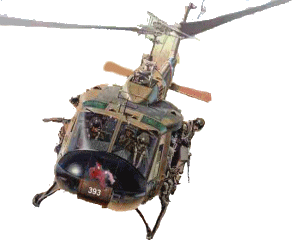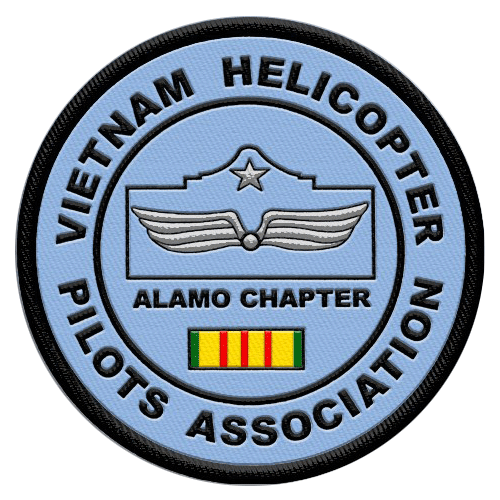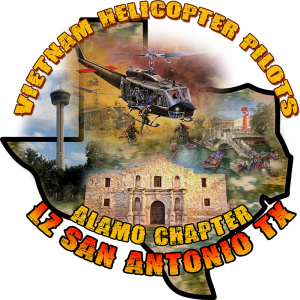|
Thank You from Texas Tech for your Donations
Received: Nov
27, 2028
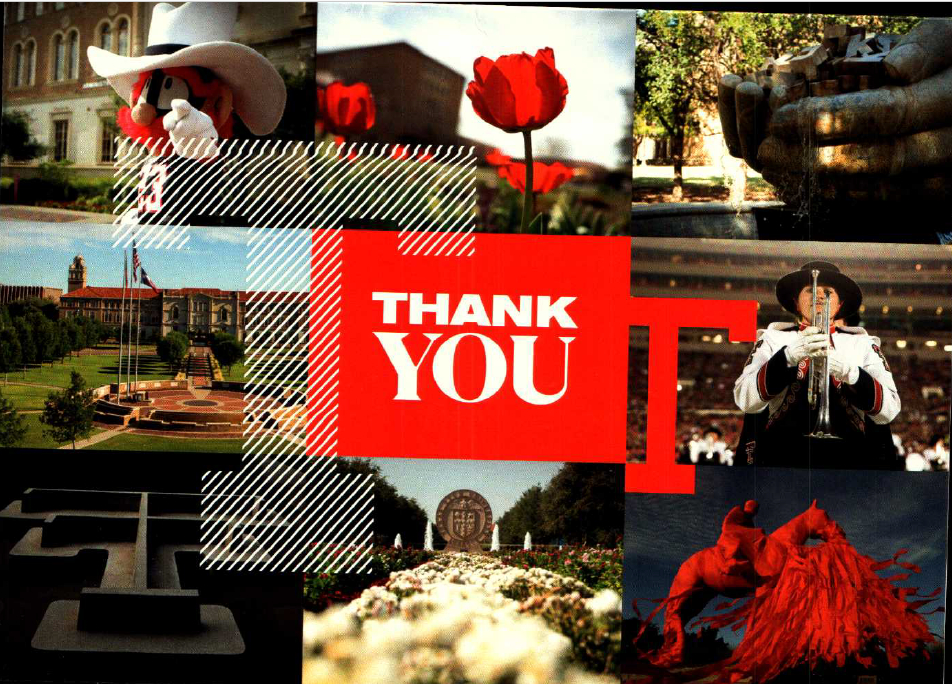
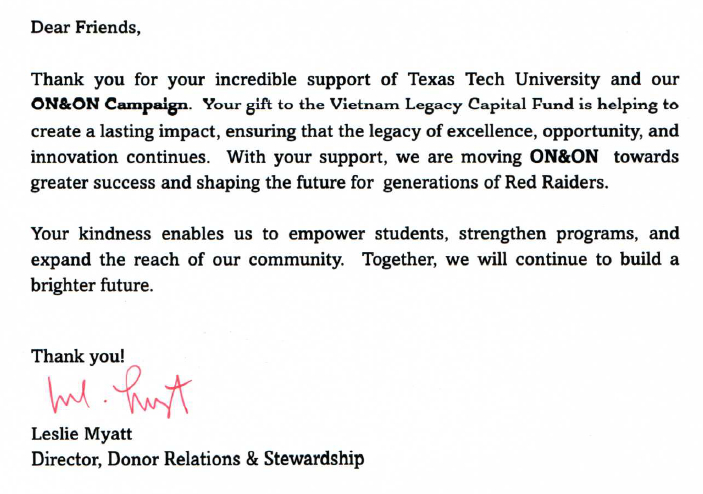
**************************************************
October 27, 2025:
The following
information conserning San
Antonio Airport Parking
affecting DV and
Special License Plate recepients has been provided by
Marty and Kim Nelson.
Effective November 01, 2025 -
Privileged Parking rules will be changed - Reference:
https://www.flysatparking.com/disabled-veteran-parking
Everyone affected by these changes can go to this web
link in order to ask for assistance or to self regester
their vehicle with the San Antonio Airport Parking
Office. This link also depicts the locations of
all the airport parking areas.

**************************************************
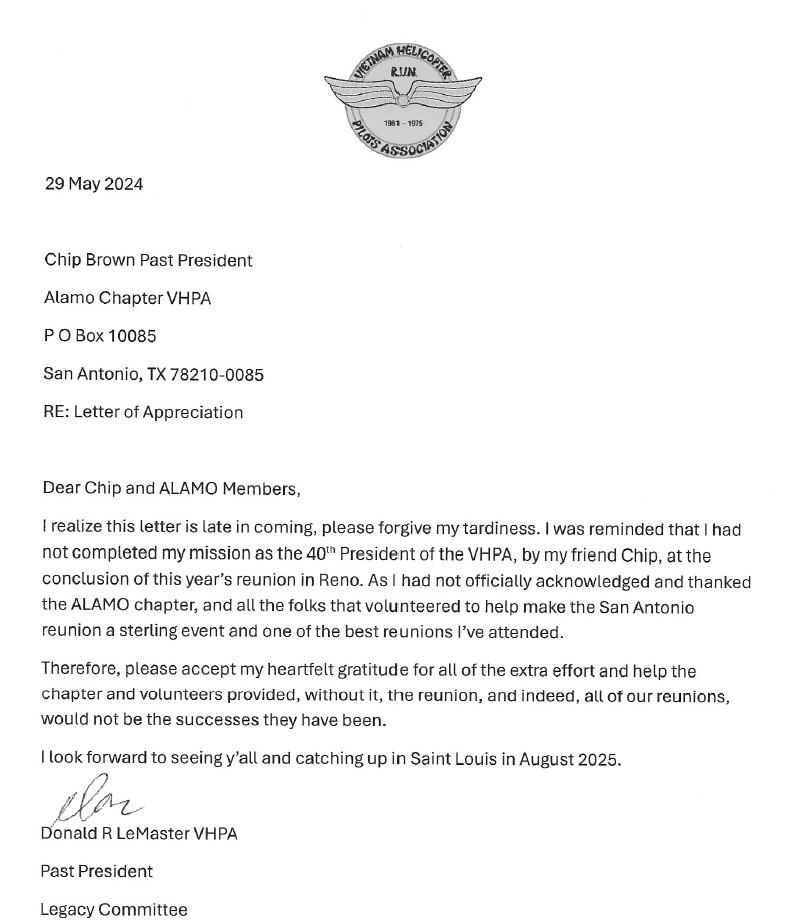
|
**************************************************
Brought to our attention by:
Al Flory
FROM THE OTHER SIDE
Authored by: Patrick Camunes
At first there was no place for
us to go until someone put up that Black Granite Wall.
Now, everyday and night, my Brothers and my
Sisters wait to see the many people from places afar
file in front of this Wall.
Many stopping briefly, many for hours, and some
come on a regular basis.
It was hard at first, not that it's gotten any
easier, but it seems that many of the attitudes towards
that war that we were involved in have changed.
I can only pray that the ones on the other side
have learned something, and more Walls as this one
needn't be built.
Several members of my unit and
many that I did not recognize have called me to the Wall
by touching my name that is engraved upon it.
The tears aren't necessary, but are hard even for
me to hold back.
Don't feel guilty for not being with me, my
Brothers.
This was my destiny, as it is yours to be on that side
of the Wall.
Touch the Wall, my Brothers, so
that we can share in the memories that we had.
I have learned to put the bad memories aside, and
remember only the pleasant times that we had together.
Tell our other Brothers out there to come and
visit me, not to say Good Bye, but to say Hello so we
can be together again - even for a short time in order
to ease the pain of loss that we all share.
Today, an irresistible and
loving call comes from the Wall.
As I approach I can see an elderly lady, and as I
get closer I recognize her.......It's Momma!
As much as I have looked forward to this day, I
have also regretted it - because I didn't know what
reaction I would have.
Next to her, I suddenly see my
wife - and immediately think how hard it must have been
for her to come to this place, and my mind floods with
the pleasant memories of 30 years past.
There's a young man in a military uniform
standing with his arm around her......My
God!......It's...it has to be my son.
Look at him trying to be the man without a tear
in his eye.
I yearn to tell him how proud I am, seeing him standing
tall, straight and proud in his uniform.
Momma comes closer, touches the
Wall, and I feel the soft and gentle touch I had not
felt in so many years.
Dad has crossed to this side of the Wall, and
through our touch - I try to convey to her that Dad is
doing fine - for he no longer suffes or feeling pain.
I see my wife's courage building as she sees
Momma touch the Wall and she approaches and lays her
hand on my waiting hand.
All the emotions, feelings and memories of three
decades past flash between our touch, and I tell her
that it's all right.
Carry on with your life, and don't worry about
me......I can see as I look into her eyes that she hears
and understands me, and a big burden has been lifted
from her.
I watch as they lay flowers and
other memories of my past.
My lucky charm that was taken from me and sent to
her by my CO, a tattered and worn teddy bear that I can
barely remember having as I grew up as a child, and
several medals that I had earned but were presented to
my wife. One
of them is the Combat Infantry Badge that I am very
proud of, and I notice that my son is also wearing this
medal. I had
earned mine in the jungles of Vietnam, and he had
probably earned his in the deserts of Iraq.
I can tell that they are
preparing to leave, and I try to take a mental picture
of them together - because I don't know when I will see
them again.
I wouldn't blame them if they were not to return, and
can only thank them that I was not forgotten.
My wife and Momma near the Wall for one final
touch, I know that so many years of indecision, fear,
and sorrow are let go.
As they turn to leave - I feel my tears that had
not flowed for so many years - form as if dew drops on
the other side of the Wall.
They slowly move away with only
a glance over their shoulder.
My son suddenly stops and slowly returns.
He stands straight and proud in front of me, and
snaps a salute.
Something makes him move to the Wall and he puts
his hand upon the Wall and touches my tears that had
formed on the face of the Wall - and I can tell that he
senses my presence there, and feels my pride and the
love that I have for him.
He falls to his knees, the tears flow from his
eyes - I try my best to reassure him that it's all right
and the tears do not make him any less of a man.
As he moves back wiping the
tears from his eyes, he silently mouths, God bless you,
Dad......
God Bless You, Son......
We WILL meet someday - but in the meanwhile, go
on your way......
There is no hurry.......There is no hurry at all.
As I see them walk off in the
distance, I yell out to THEM and EVERYONE
there today, as loud as I can,.........THANKS FOR
REMEMBERING - and as others on this side of the Wall
join in - I notice that the US Flag that so proudly
flies in front of us everyday is flapping and standing
proudly - straight out in the wind today . . . . . . . .
THANK YOU ALL FOR REMEMBERING
**************************************************
Brought to our attention
by Jim Talley:
ARMY Air Crewmembers Line of Duty Deaths
Listed by Aircraft Types and Years - including
1963-73 Vietnam time frame
showning
Units
**************************************************
Brought to our attention by David Baum:
Sam Johnson Vietnam Archieves
https://www.bonusprint.co.uk/view-online-photo-book?widgetId=cd032c41-b413-4185-9871-847c75681676
**************************************************
Brought to our attention by Johathon Logan:
Video - Flight to honor father she
never met
https://youtu.be/1HqG-8fdV9o
**************************************************
Brought to our attention by
Matt Brockway: Vietnam
Aircraft Losses
https://www.nhahistoricalsociety.org/wp-content/uploads/2017/08/aircraftlossesofthevietnamwarnhahs.pdf
**************************************************
Brought to our attention by Charles Edwards:
LETTER ON WHETHER TO BECOME AN ARMY OR NAVAL AVIATOR, OR
AN AIR FORCE PILOT.
The
piece is written by Bob Norris, a former Naval aviator who
also did a 3 year exchange tour flying the F-15 Eagle.
He is now an accomplished author of entertaining books about
U.S. Naval Aviation including "Check Six" and "Fly-Off".
In response to a letter from an aspiring fighter pilot
on which military academy to attend, Bob replied with the
following:
Young Man,
Congratulations on your
decision to select
the Army, or the Naval, or Air Force Academy. Your goal of
becoming a pilot is impressive and a fine way to serve your
country. As you requested, I'd be happy to share some
insight into which service would be the best choice.
Each service has a distinctly different culture. You
need to ask yourself "Which one am I more likely to thrive
in?"
USAF Snapshot: The USAF is exceptionally well
organized and well run. Their training programs are
terrific. All pilots are groomed to meet high
standards for knowledge and professionalism. Their
aircraft are top-notch and extremely well maintained.
Their facilities are excellent. Their enlisted
personnel are the brightest and the best trained. The
USAF is homogenous and macro. No matter where you go,
you'll know what to expect, what is expected of you, and
you'll be given the training & tools you need to meet those
expectations. You will never be put in a situation
over your head. Over a 20-year career you will be home
for most important family events. Your Mom would want
you to be an Air Force pilot...so would your wife.
Your Dad would want your sister to marry one.
Navy
Snapshot: Aviators are part of the Navy, but so are Black
Shoes (surface warfare) and Bubble Heads (submariners).
Furthermore, the Navy is split into two distinctly different
Fleets (West and East Coast). The Navy is
heterogeneous and micro. Your squadron is your home;
it may be great, average, or awful. A squadron can go
from one extreme to the other before you know it. You
will spend months preparing for cruise and months on cruise.
The quality of the aircraft varies directly with the
availability of parts. Senior Navy enlisted are salt
of the earth; you'll be proud if you earn their respect.
Junior enlisted vary from terrific to the troubled kid the
judge made join the service. You will be given the
opportunity to lead these people during your career; you
will be humbled and get your hands dirty. The quality
of your training will vary and sometimes you will be over
your head. You will miss many important family events.
There will be long stretches of tedious duty aboard ship.
You will fly in very bad weather and/or at night and you
will be scared many times. You will fly with legends in the
Navy and they will kick your ass until you become a lethal
force. And some days - when the scheduling Gods have
smiled upon you - your jet will catapult into a glorious
morning over a far-away sea and you will be drop-jawed that
someone would pay you to do it. The hottest girl in
the bar wants to meet the Naval Aviator. That bar is
in Singapore.
Bottom line, son, if you gotta
ask...pack warm & good luck in Colorado.
P.S.: Air
Force pilots wear scarves and iron their flight suits.
P.S.S. And oh, yes, the Army helicopter pilot program? Don't even think about it unless you got a pair bigger than
basketballs. Those guys are completely crazy!
**************************************************
Vietnam War ‘Dustoff’ helicopter crews to receive
Congressional Gold Medal
By
GARY WARNER STARS AND STRIPES
• September 20, 2024
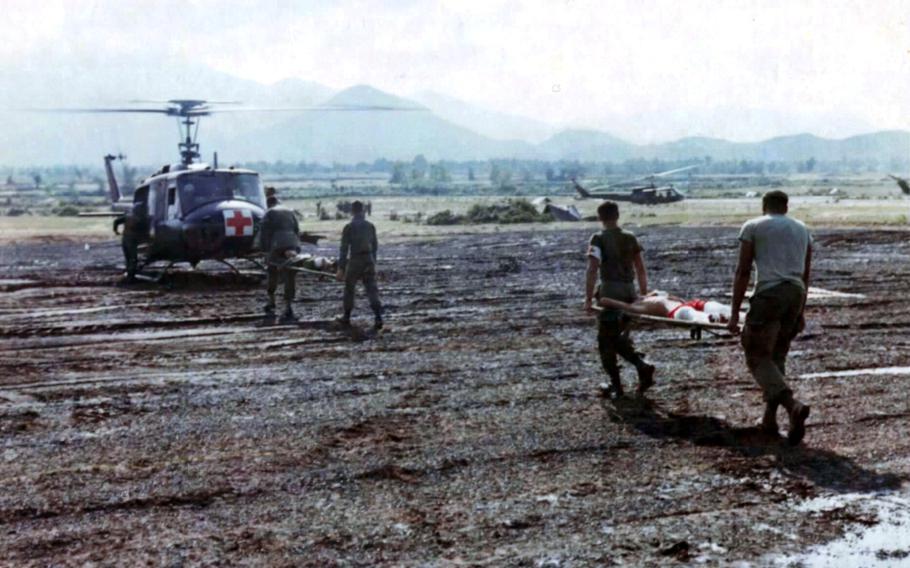
Stretcher-bearers in September 1966 carry wounded to
“Dustoff” medevac helicopters at a 1st Air Cavalry base
near Qui Nhon in Vietnam on the South China Sea, about
375 miles northeast of Saigon. (Lawrence J.
Sullivan/National Museum of the United States Army).
Vietnam War medevac helicopter crews will be the latest
military group to receive the highest award Congress can
bestow. The Dustoff Crews of the Vietnam War
Congressional Gold Medal Act won final approval this
week (Sep, 2024).
It honors the estimated 3,000 pilots, medics, and crew
who flew between combat zones and field hospitals during
the war. The flights were nicknamed “Dustoff” because of
the dirt and debris churned up by their helicopter
rotors as they landed to pick up wounded. The crew
of a helicopter early in the war took the name as their
call-sign, according to the Army. The Dustoffs
extracted 900,000 wounded U.S., Vietnamese, and allied
soldiers from May 1962 to March 1973. Army said
the medevac crews had a one-in-three chance of becoming
casualties themselves. “They were some of the very
best, and their heroism deserves to be recognized, which
we finally did [Thursday] by sending this legislation to
President [Joe] Biden’s desk to become law,” said Rep.
Cathy McMorris Rodgers, R-Wash., a co-sponsor of the
legislation. Congressional testimony included the
record of the 54th Medical Detachment, a Dustoff unit of
about 30 soldiers with three UH-1 Huey helicopters.
During one 10-month stretch of heavy fighting, they
extracted 21,435 casualties to safety. The 8,644
evacuation and rescue missions required 4,832 hours in
the air. Unit members received 78 valor awards.
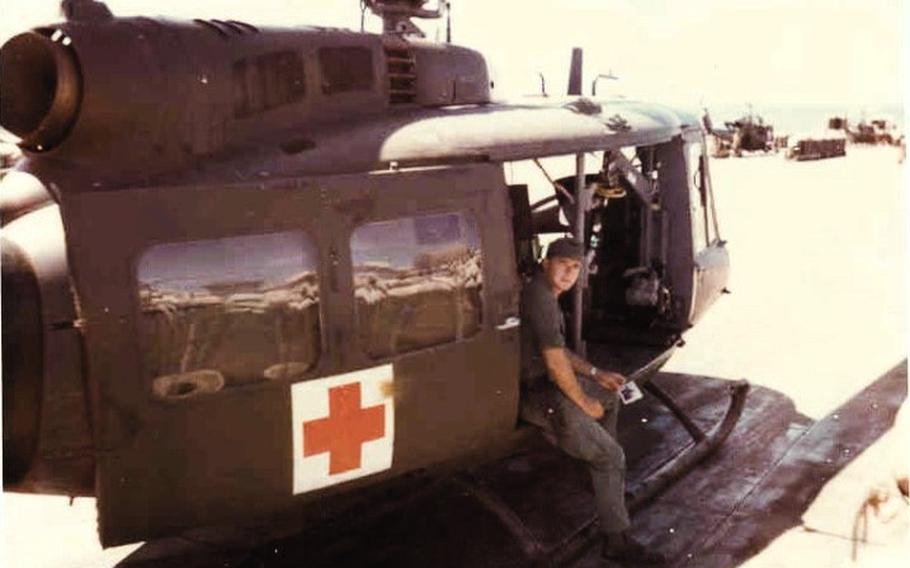
Patrick Henry Brady (Honorary Life
Member with the Alamo Chapter VHPA)
of Seattle was an Army major flying missions with the
54th Medical Detachment from Chu Lai, about 340 miles
northeast of Saigon on the coast of the South China Sea.
In January 1968, calls came in from groups of wounded
soldiers who were trapped behind enemy lines, including
one group in a mine field. Despite heavy fog and
smoke, Brady extracted soldiers from a site where two
early rescue helicopters had been shot down.
Returning several times to pull more soldiers out of the
jungle, Brady had one helicopter shredded by machine gun
fire and a second damaged at the mine field by an
explosion. At the end of the day, Brady and his
crew had lost three helicopters and saved 51 wounded
American and South Vietnamese soldiers. Army Maj.
Patrick Henry Brady, in an undated photo, served as a
“Dustoff” medical evacuation pilot during the Vietnam
War. He received the Medal of Honor for valor
during a dangerous landing to pick up wounded soldiers
in January 1968. He retired from the service as a
Major General. (Congressional Medal Of Honor Society)
Brady received the Medal of Honor, the nation’s highest
award for valor in combat. “A Dustoff was usually
vulnerable,” he said. “Of course, the most dangerous
time was landing on the battlefield during the battle.
The chopper was big and visible -- no armor protection.”
Brady said despite the red cross painted on the Dustoffs
to show they weren’t combat helicopters, they
nonetheless always drew enemy fire. “We knew it
and we were never surprised,” he said. “We did all we
could to avoid it. That meant finding the safest
way in, taking the shortest time on the ground possible
and getting the patient to the hospital as soon as we
could.
” Vietnam Dustoff Association President Steve Vermillion
said the Congressional Gold Medal recognized the history
of what were often teenagers involved in a life and
death mission all day, nearly every day. “[It’s]
the story of 18- and 19-year-old men flying unarmed
helicopters into battle, at night, in the rain, and
multiple times a day, to rescue our wounded and fly them
back to medical facilities,” he said. The
Congressional Gold Medal requires two-thirds of each
chamber to support the bill. In the
Democratic-controlled Senate, 71 of 100 senators signed
on as co-sponsors. In the Republican-controlled House,
330 of the 435 members endorsed the legislation.
The final votes this week sent the legislation to Biden.
The White House said Thursday that he planned to sign
the bill into law. The Congressional Gold Medal
was first awarded in 1776 to Gen. George Washington for
his service in the early days of the American
Revolution. In the 248 years since, it has gone to
more than 300 individuals and organizations, such as the
American Red Cross. Top American generals, from
Horatio Gates in the Revolutionary War to Norman
Schwarzkopf in Operation Desert Storm, have received the
medal. In the past two decades, Congress has
honored various groups such as the Native American code
talkers from World War II who translated secret orders
and other messages into their native language, which
Japanese troops in the Pacific could not understand.
Other medal recipients included the Montford Point
Marines, the first Black troops to serve in the branch,
the “Monuments Men,” experts recruited by the Army to
find art stolen by the Nazis, and Merrill’s Marauders,
World War II Army commandos who fought behind enemy
lines in Burma. The Congressional Gold Medal has
also gone to artists, explorers, astronauts,
politicians, and business leaders. Recipients have
included the Wright Brothers, Bob Hope, Joe Louis,
Robert Frost, Frank Sinatra, and Mother Teresa. Each
medal is created with a unique design from the U.S. Mint
honoring the recipient. In the case of groups such as
the Dustoff crews, only one gold medal is produced.
The one medal for groups is usually displayed at the
Smithsonian Institution or other public display space.
The law firm Hunton Andrews Kurth, which assisted the
effort to obtain the medal for the Dustoff crews, said
the veterans had chosen the U.S. Army Medical Department
Museum in Fort Sam Houston, Texas, to display the medal.
|
One Hundred Eighteenth Congress
of
the
United States of America
AT THE SECOND SESSION
Begun and held at the City of Washington
on Wednesday,
the third day of January,
two thousand and twenty four
To award a Congressional Gold Medal to the
United States Army Dustoff crews of the
Vietnam War, collectively, in recognition of
their extraordinary heroism and life-saving
actions in Vietnam.
Be it enacted by the Senate and House of
Representatives of the United States of America
in Congress assembled,
SECTION 1. Short
title.
This Act may be cited as the “Dustoff Crews
of the Vietnam War Congressional Gold Medal
Act”.
SEC. 2. Findings.
(1) a United States Army Dustoff crewman,
including a pilot, crew chief, and medic, is a
helicopter crew member who served honorably
during the Vietnam War aboard helicopter air
ambulances, which were both nondivision and
division assets under the radio call signs
“Dustoff” and “Medevac”;
(2) Dustoff crews performed aeromedical
evacuation for United States, Vietnamese, and
allied forces in Southeast Asia from May 1962
through March 1973;
(3) nearing the end of World War II, the United
States Army began using helicopters for medical
evacuation and years later, during the Korean
War, these helicopter air ambulances were
responsible for transporting 17,700 United
States casualties;
(4) during the Vietnam War, with the use of
helicopter air ambulances, United States Army
Dustoff crews pioneered the concept of dedicated
and rapid medical evacuation and transported
almost 900,000 United States, South Vietnamese,
and other allied sick and wounded, as well as
wounded enemy forces;
(5) helicopters proved to be a revolutionary
tool to assist those injured on the battlefield;
(6) highly skilled and intrepid, Dustoff crews
were able to operate the helicopters and land
them on almost any terrain in nearly any weather
to pick up wounded, after which the Dustoff
crews could provide care to these patients while
transporting them to ready medical facilities;
(7) the vital work of the Dustoff crews required
consistent combat exposure and often proved to
be the difference between life and death for
wounded personnel;
(8) the revolutionary concept of a dedicated
combat life-saving system was cultivated and
refined by United States Army Dustoff crews
during 11 years of intense conflict in and above
the jungles of Southeast Asia;
(9) innovative and resourceful Dustoff crews in
Vietnam were responsible for taking the new
concept of helicopter medical evacuation, born
just a few years earlier, and revolutionizing it
to meet and surpass the previously unattainable
goal of delivering a battlefield casualty to an
operating table within the vaunted “golden
hour”;
(10) some Dustoff units in Vietnam operated so
efficiently that they were able to deliver a
patient to a waiting medical facility on an
average of 50 minutes from the receipt of the
mission, which saved the lives of countless
personnel in Vietnam, and this legacy continues
for modern-day Dustoff crews;
(11) the inherent danger of being a member of a
Dustoff crew in Vietnam meant that there was a 1
in 3 chance of being wounded or killed;
(12) many battles during the Vietnam War raged
at night, and members of the Dustoff crews often
found themselves searching for a landing zone in
complete darkness, in bad weather, over
mountainous terrain, and all while being the
target of intense enemy fire as they attempted
to rescue the wounded, which caused Dustoff
crews to suffer a rate of aircraft loss that was
more than 3 times that of all other types of
combat helicopter missions in Vietnam;
(13) the 54th Medical Detachment typified the
constant heroism displayed by Dustoff crews in
Vietnam, over the span of a 10-month tour, with
only 3 flyable helicopters and 40 soldiers in
the unit, evacuating 21,435 patients in 8,644
missions while being airborne for 4,832 hours;
(14) collectively, the members of the 54th
Medical Detachment earned 78 awards for valor,
including 1 Medal of Honor, 1 Distinguished
Service Cross, 14 Silver Star Medals, 26
Distinguished Flying Crosses, 2 Bronze Star
Medals for valor, 4 Air Medals for valor, 4
Soldier’s Medals, and 26 Purple Heart Medals;
(15) the 54th Medical Detachment displayed
heroism on a daily basis and set the standard
for all Dustoff crews in Vietnam;
(16) 6 members of the 54th Medical Detachment
are in the Dustoff Hall of Fame, 3 are in the
Army Aviation Hall of Fame, and 1 is the only
United States Army aviator in the National
Aviation Hall of Fame;
(17) Dustoff crew members are among the most
highly decorated soldiers in United States
military history;
(18) in early 1964, Major Charles L. Kelly was
the Commanding Officer of the 57th Medical
Detachment (Helicopter Ambulance), Provisional,
in Soc Trang, South Vietnam;
(19) Major Kelly helped to forge the Dustoff
call sign into history as one of the most
welcomed phrases to be heard over the radio by
wounded soldiers in perilous and dire
situations;
(20) in 1964, Major Kelly was killed in action
as he gallantly maneuvered his aircraft to save
a wounded United States soldier and several
Vietnamese soldiers and boldly replied, after
being warned to stay away from the landing zone
due to the ferocity of enemy fire, “When I have
your wounded.”;
(21) General William Westmoreland, Commander of
the Military Assistance Command, Vietnam from
1964 to 1968, singled out Major Kelly as an
example of “the greatness of the human spirit”
and highlighted his famous reply as an
inspiration to all in combat;
(22) General Creighton Abrams, successor to
General Westmoreland from 1968 to 1972, and
former Chief of Staff of the United States Army,
highlighted the heroism of Dustoff crews, “A
special word about the Dustoffs . . . . Courage
above and beyond the call of duty was sort of
routine to them. It was a daily thing, part of
the way they lived. That’s the great part, and
it meant so much to every last man who served
there. Whether he ever got hurt or not, he knew
Dustoff was there.”;
(23) Dustoff crews possessed unique skills and
traits that made them highly successful in
aeromedical evacuation in Vietnam, including
indomitable courage, extraordinary aviation
skill and sound judgment under fire, high-level
medical expertise, and an unequaled dedication
to the preservation of human life;
(24) members of the United States Armed Forces
on the ground in Vietnam had their confidence
and battlefield prowess reinforced knowing that
there were heroic Dustoff crews just a few
minutes from the fight, which was instrumental
to their well-being, willingness to fight, and
morale;
(25) military families in the United States knew
that their loved ones would receive the quickest
and best possible care in the event of a
war-time injury, thanks to the Dustoff crews;
(26) the willingness of Dustoff crews to also
risk their lives to save helpless civilians left
an immeasurably positive impression on the
people of Vietnam and exemplified the finest
United States ideals of compassion and humanity;
and
(27) Dustoff crews from the Vietnam War hailed
from every State in the United States and
represented numerous ethnic, religious, and
cultural backgrounds.
SEC. 3. Congressional
gold medal.
(a) Presentation
authorized.—The Speaker of the House of
Representatives and the President pro tempore of
the Senate shall make appropriate arrangements
for the presentation, on behalf of Congress, of
a single gold medal of appropriate design in
honor of the Dustoff crews of the Vietnam War,
collectively, in recognition of their heroic
military service, which saved countless lives
and contributed directly to the defense of the
United States.
(b) Design
and striking.—For purposes of the
presentation referred to in subsection (a), the
Secretary of the Treasury (referred to in this
Act as the “Secretary”) shall strike a gold
medal with suitable emblems, devices, and
inscriptions, to be determined by the Secretary,
in consultation with the Secretary of Defense.
(c) U.S.
Army Medical Department Museum.—
(1) IN
GENERAL.—Following the award of the gold medal
in honor of the Dustoff Crews of the Vietnam
War, the gold medal shall be given to the U.S.
Army Medical Department Museum, where it will be
available for display as appropriate and
available for research.
(2) SENSE
OF CONGRESS.—It is the sense of Congress that
the U.S. Army Medical Department Museum should
make the gold medal awarded pursuant to this Act
available for display elsewhere, particularly at
appropriate locations associated with the
Vietnam War, and that preference should be given
to locations affiliated with the U.S. Army
Medical Department Museum.
SEC. 4. Duplicate
medals.
The Secretary may strike and sell duplicates
in bronze of the gold medal struck under
section 3, at a price sufficient to cover
the costs thereof, including labor,
materials, dies, use of machinery, and
overhead expenses.
SEC. 5. Status
of medals.
(a) National
medal.—Medals struck pursuant to this Act
are national medals for purposes of chapter
51 of title 31, United States
Code.
(b) Numismatic
items.—For purposes of sections 5134 and
5136 of title 31, United States Code, all medals
struck under this Act shall be considered to be
numismatic items.
SEC. 6. Authority
to use fund amounts; proceeds of sale.
(a) Authority
To use fund amounts.—There is authorized
to be charged against the United States Mint
Public Enterprise Fund such amounts as may be
necessary to pay for the costs of the medals
struck under this Act.
(b) Proceeds
of sale.—Amounts received from the sale
of duplicate bronze medals authorized under
section 4 shall be deposited into the United
States Mint Public Enterprise Fund.
Speaker of the House of
Representatives
|
Vice President of the United
States and President of the Senate |
|
|
**************************************************
|
